October 29 - November 4, 2023: Issue 603
Ringtail Posse 9: October 2023
David Palmer OAM: Bandicoots, Helen Pearce: Brushtail Possum, Amina Kitching: Goanna, David Goudie: Ringtails Possums + Bandicoots + Owls
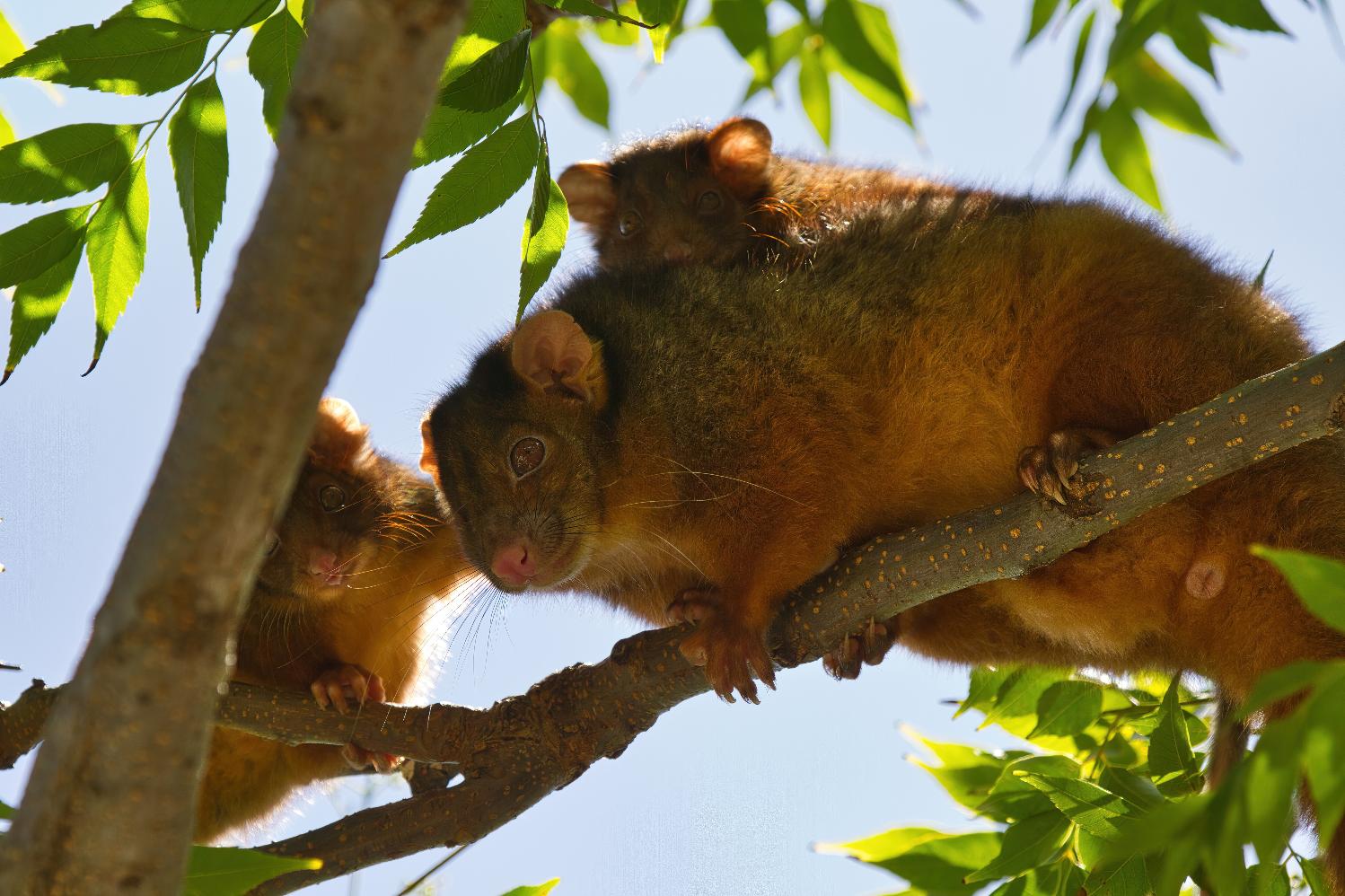
Definition from:
Ringtail: from the 'Common Ringtail Possum' which is not so common anymore in urban areas. The Common Ringtail Possum is found along the entire eastern part of Australia and south west Western Australia. They are also found throughout Tasmania. The western ringtail possum is a threatened species under State and Commonwealth legislation. In Western Australia the species is listed as Critically Endangered fauna under the Biodiversity Conservation Act 2016.
+
Posse: noun. 1 : a large group often with a common interest 2 : a body of persons summoned by a sheriff to assist in preserving the public peace usually in an emergency 3 : a group of people temporarily organised to make a search (as for a lost child) 4 : one's attendants or associates.
On Wednesday June 21st 2023 a Motion regarding Heritage Protection was passed in the NSW Parliament. Tabled by The Hon. Peter Primrose, contributors to the discussion spoke of the Minns Government's commitment to developing the State's first heritage strategy, in which the Government will develop options to recognise and protect significant trees, urban bushland and wildlife corridors.
This was, of course, music to the ears of all who are working at ground level in these areas to safeguard the survival of the urban wallaby, koala, lizard, skink, snake, bandicoot, every bird of woodland, water and grassland, insects and every other wildlife species we share suburbia with.
However, since then and the September Round of the Ringtail Posse The Department of Environment's Wildlife rehabilitation data has been updated to 30 June 2022 and now records 37, 815 wildlife animals have been rescued in this LGA and just 10, 609 released from the collected data period of June 2013 to June 2023.
The 2021/22 total is 5431 with just 1449 released. The Data to 30 June 2021 listed of the 5, 235 animals rescued during that 2020 to 2021 period just 1,573 were released.
So the June 2021 to June 2022 data reveals an increase of 196 animals and a staggering 3, 982 animals have lost their lives in this LGA during the latest updated data period, with the so called 'Common' Ringtail Possum again the most impacted species, with 1166 lost. The others most lost have been Rainbow Lorikeets; 603, Brushtail Possums: 521, with the Kookaburra and Magpie both listed as 246 each lost.
Collisions with motor vehicles, 'unsuitable environment', meaning they're in someone's roof because their trees have been cut down, fallen from nest or tree, and attacks by cats are listed as the primary causes for these deaths. People speeding in suburban roads, clearing habitat, frightening mothers so babies drop, and not keeping their pets indoors at night are what has caused these deaths.
In approved DA’s Council now lists as a requirement of consent in Assessment reports to look after the other residents of this area, the wildlife. On blocks where people wish to remove large amounts of trees that are clearly homes for local fauna a wildlife expert must assess these prior to any removal taking place, nesting boxes are required to be installed afterward and Ecologists must be on site during their removal.
Recent examples and instances are:
Bandicoot/Penguin (Avalon)
Long-nosed Bandicoots & Little Penguins – Best Practices for Residents
Residents are encouraged to follow a number of Best Practices to assist with the protection and management of the endangered populations of Long-nosed Bandicoots and Little Penguins:
Long-nosed Bandicoots, Little Penguins and other native animals should never be fed as it may cause them nutritional problems, hardship if supplementary feeding is stopped, and it may increase predation.
Feral cats or foxes should never be fed or food left out where they can access it, such as rubbish bins without lids or pet food bowls, as these animals present a significant threat to Long-nosed Bandicoots, Little Penguins and other wildlife.
The use of insecticides, fertilisers, poisons and/or baits should be avoided on the property.
Garden insects will be kept in low numbers if Long-nosed Bandicoots are present.
When the North Head Long-nosed Bandicoot Recovery Plan is released it should be implemented where relevant.
Dead Long-nosed Bandicoots or Little Penguins should be reported by phoning Manly Council on 9976 1500 or Department of Environment and Conservation on 9960 6266.
Please drive carefully as vehicle related injuries and deaths of Long-nosed Bandicoots and Little Penguins have occurred in the area. Care should also be taken at night in the drive way when moving cars as bandicoots will seek shelter beneath vehicles.
Cat/s and or dog/s that currently live on the property should be kept indoors at night to avoid disturbance/death of native animals. Ideally, when the current cat/s and/or dog/s that live on the property no longer reside on the property it is recommended that they not be replaced by new dogs or cats.
Report all sightings of feral rabbits, feral or stray cats and/or foxes to N B Council.
And;
Protection of Habitat Features
All natural landscape features, including any rock outcrops, native vegetation and/or watercourses, are to remain undisturbed during the construction works, except where affected by necessary works detailed on approved plans.
Reason: To protect wildlife habitat.
The Reason given in all instances is: To protect native wildlife.
This follows on from the 2022 Local Government NSW Conference where a Motion was passed - That Local Government NSW lobby the NSW Government to:
- In conjunction with industry associations, introduce enforceable standards for the preparation of flora and fauna management plans.
- Consider Codes of Practice and Guidelines for handling native wildlife and other best practice and animal welfare laws in development of the standards.
- Consult with Councils, National Parks and Wildlife Service, Ecological Consultants Association of NSW, wildlife rescue organisations and other relevant agencies in the preparation of standards.
Such a standard should include requirements for:
- Pre-clearance surveys to be carried out to establish which species are present on the site, including identification of any threatened and native species.
- The identification of suitable nearby areas where wildlife could possibly be relocated.
- The provision of possum, glider and bat boxes sufficiently in advance of vegetation clearing to allow wildlife time to discover the boxes and become familiar with them.
- Compliance with the NSW Code of Practice for Injured, Sick and Orphaned Protected Fauna and the licencing requirements contained in the Biodiversity Conservation Act 2016.
- Best practice for wildlife handling and care (including contact with local wildlife rescue groups).
- Reporting of injured or killed fauna to the NSW Department of Planning, Industry and Environment to enable the data to be used in statewide biodiversity monitoring programs.
The premise of this is that mandatory pre-clearance surveys to establish what wildlife lives there before works commence, and to document this in a formal way, should be required on any site that has vegetation and for which a DA has been approved. The experience is that often vegetation is removed before an application is submitted, often leaving wildlife with no home. Wildlife then ends up on roads dead or dies after being displaced/evicted.
One wildlife carer cited a recent Pittwater case of a powerful owl pair site that had had vegetation removed to make the development more likely to proceed – the nest and two babies were destroyed.
‘It’s hard to prove wildlife is/was present after the clearing as they aren’t there.’
‘Once trees and vegetation are removed the problem is where do these animals go?’
Powerful Owls are also not so common anymore in urban areas.
However it's clear human residents of this LGA have a deep and abiding love for and connection to these other furry, scaled, finned and feathered locals. We listen for them during the night, happy when we hear their footsteps scampering across our rooves and fences or their soft hoots across the valleys.
We look out for them during the day, delighted with their presence.
Residents here are distressed when they find injured wildlife or witness wildlife being attacked. They are not in denial that all our local wildlife feels and thinks - they cry when their babies are killed in front of them, mourn the loss of a mate - people who have heard or seen this never forget.
Overall the updated data now states 785, 74 animals have been rescued across New South Wales and 218, 126 released. These figures and data do not take into account all the wildlife found deceased beside or on roads or elsewhere.
''This study draws on 469,553 rescues reported over six years by wildlife rehabilitators for 688 species of bird, reptile, and mammal from New South Wales, Australia.... Of the 364,461 rescues for which the fate of an animal was known, 92% fell within two categories: ‘dead’, ‘died or euthanised’ (54.8% of rescues with known fate) and animals that recovered and were subsequently released (37.1% of rescues with known fate).''In total, there were 872,087 records reported during the six-year (2013–14 to 2018–19) study period. Just over 97% of these came from three animal groups–birds, mammals, and reptiles. Of the total number of records, 402,534, (46%) were excluded from the descriptive analysis because they: a) did not contain any information about the animal, or the animal’s identification was ambiguous and could not be placed within a group (e.g. an ‘unidentified animal’); b) contained only sightings of animals and were not attended to in some way by a wildlife rehabilitator; c) were records of amphibians (373 records) or non-vertebrate fauna (e.g. spiders, insects, etc.); d) were non-avian marine vertebrates such as whales, seals, sharks, rays, fish etc; e) were reported as floating, drowned, or washed up animals (deemed an ambiguous cause for rescue, n = 48); f) contained both an ‘unknown’ cause for rescue and an ‘unknown’ fate; or f) were an introduced or spurious species (e.g. extinct, or out of known range). These exclusions resulted in a dataset for descriptive analysis of 469,553 records i.e. 54% of the initially reported amount.''
Many people state we are the generation witnessing the extinction of urban wildlife. There has been generation after generation of humans living alongside and with wildlife, until this one.
It's not just the Pittwater koalas that have gone, other species, like the ringtail possum or long-nosed bandicoot are disappearing, along with their joyful snuffles and squeaks, from our urban backyards and the trees that tower over them.
There is a growing silence at night for those species that forage for food then - possums, wallabies, owls. The same is occurring for those that are active during daylight.
Although many point to the impacts of cat and dog attacks due to irresponsible owners, there is also what is termed the 'inconvenient possum' in a roof or garden shed, because its home tree has been cut down. These are caught by those hired, some of whom have little knowledge or scruples, and release them into areas out of their home range - a death sentence for that possum as this species is territorial, along with requiring certain food trees in order to eat, to survive.
There is predation by other introduced species - readers regularly send in photos and videos of foxes roaming and killing at night.
There are roadkill black spots, places where wallabies or turtles or possums used to cross the area where a road has been cut through and a speed limit that means death for wildlife. There are no 'speed humps' in place, and no plan at a local, state or federal government level to install these. Residents and wildlife rescuers have reported some drivers 'aiming straight for' a stricken animal.
There is the razing of blocks of land for development prior to any required assessment of the environment taking place to circumvent those requirements so a report can state 'nothing present'. There is nothing present because its habitat has been cleared or the wildlife killed by these actions.
Our local wildlife carers are exhausted, state there have been so many, too many for too long - they are increasingly heartbroken with all the babies they lose, they cry every day, and then pick themselves up and get on with trying to save the next critter, and the next.
Wildlife carers are all volunteers - they do the rescues, sometimes horrific rescues, run to and fro from the great local vets who help out trying to save them, they gather or pay for the food, for the milk, for the petrol, for the electricity to keep bubs warm. There are no grants or funding for Australia's wildlife carers - they have to raise funds through running events, raising awareness, collecting cans for a 10 cent return.
This year a celebration of residents' favourite wildlife runs as Profiles across 2023 - simply to allow those who love a chosen 'critter' to speak for them a little, to remind us of what is here and what we feel connected to has feelings too.
Information about these species and how many or why we are losing them is included - just so we can think about how we, as individuals and as one community, can turn around that growing silent emptiness closing in around us and these other ones we love.
Ultimately the founders of the Ringtail Posse are hoping everyone chooses to become a Member of the Ringtail Posse and keep their other loved one safer in its one and only home.
Reason?: To Protect Local Wildlife so it becomes 'common' and safer for our wildlife to be everywhere once more.
Further studies and reports that have come out since the last Ringtail Posse Round, along with relative information, runs below these four gentleman's favourite local wildlife species.
To join in please email us with 'Ringtail Posse' in the subject line - with so many local species of wildlife, vital insects and seals flopping around on the sand or penguins flitting through the seas and estuary, there are several on the lists that haven't been claimed for guardianship yet - what's yours?
Round 9 of Ringtail Posse Profiles includes the following now officially joined Members:
David Palmer OAM
Mona Vale
OAM For service to conservation and the environment.
Pittwater Natural Heritage Association
- Secretary, since 2010.
- Representative, Ingleside Landcare Group, 1994-2009.
- Secretary and Founding Member, Pittwater Escarpment Sub-committee, 1994-2000.
Pittwater Council
- Secretary, Sustainability Working Group, 2006-2010.
- Former Member, Planning an Integrated Built Environment Reference Group.
Environment and Conservation - Other
- Vice-President, Northern Beaches Envirolink, current.
- Member, Sustainable Northern Beaches Group, current.
- Member, Bushcare with Elanora Road, North Narrabeen Bushcare Group, 2010-2012.
- Committee Member, Friends of Narrabeen Lagoon Catchment, 2005-2011.
- Member, Project Reference Group (for the Narrabeen Lagoon - Creating a Sustainable Catchment Project), late 2000s.
- Chair, Ingleside Landcare Group, 1990s-2000s.
- Co-ordinator, Bahai Temple Bush Regeneration Project, current.
Ingleside Residents' Association
- President, mid-1990s.
- Member, 1990s-2000s.
Community - Other
- Supporter and Fundraiser, East Timor Project, Friends of Oecusse TL, early 2000s.
Author
- What's Happening to Our Creeks, (in conjunction with the Coastal Environment Centre, Pittwater Council).
- Co-Author (with Jacqui Marlow) Mitigating Impacts on Biodiversity in the Ingleside Locality by improving Fauna Connectivity.
- Co-Author (with Angus Gordon OAM) A History of the Campaign for the Preservation of the Warriewood Escarpment.
- Author, Bird Survey of the Upper Mullet Creek Valley.
Awards and recognition include:
- Finalist, Citizen of the Year, Pittwater Council, 2006.
- Environmental Volunteer of the Year, Coastal Environment Centre, Pittwater Council, 2002.
- Recognition and Reward, for Outstanding Customer Focus, Northern Sydney Institute TAFE, 2002.
- 20 Years' Service, for Recognition for valuable service to education and training in NSW TAFE, TAFE NSW.
What is your favourite local wildlife species?
I like many species that make up our amazing biodiversity but I have a real soft spot for the Long-nosed bandicoot (Perameles nasuta)
Why do you like the Long-nosed bandicoot?
Bandicoots are cute furry animals that keep a low profile, quietly going about their work feeding on curl grubs, spiders and insects . They show perseverance, living in many suburban areas in the face of numerous threats such as road traffic, foxes, dogs and cats.
Also, Bandicoots are misunderstood, for example there is a common myth that they are tick carriers. However recent studies have proven that they are no more likely to host ticks than people, our cats, our dogs or any other animal.
How long have seen or heard this animal?
I lived happily with Bandicoots for nearly 50 years in Ingleside; I used to hear them in our backyard at night. Recently we moved to Mona Vale and there is evidence of them around the neighbourhood, but they are not as common as they used to be. Unfortunately, my last sighting was of a dead bandicoot on the road outside our house
Have you noticed any changes in the number of these animals in your local neighbourhood?
Once they were prevalent in many backyards across Sydney, now the Northern Beaches is one of their last remaining strongholds. I still see their diggings in parks and reserves around Mona Vale, but seeing dead bandicoots on local roads makes me wonder how long they will be part of our suburban existence.
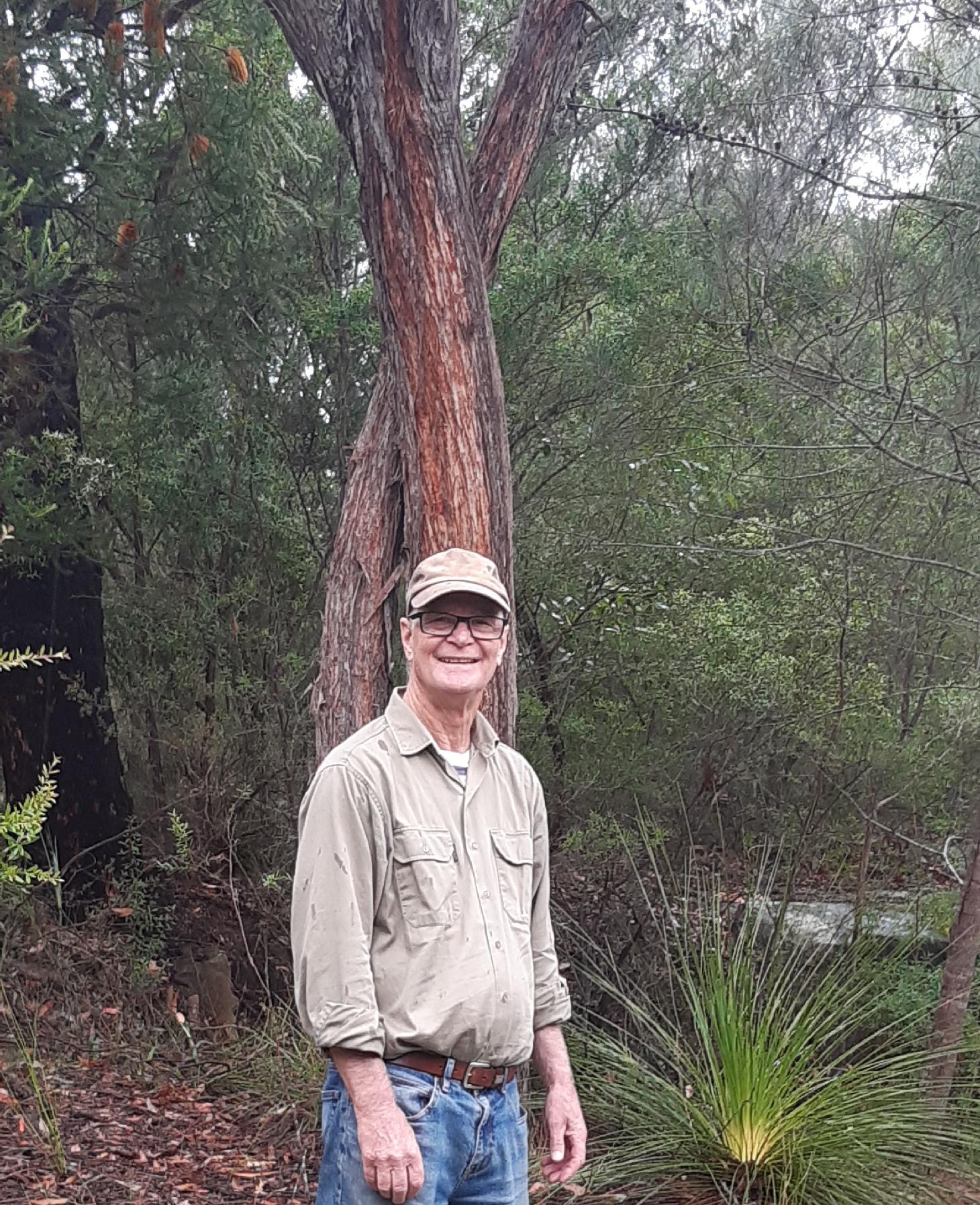
There were 94 Bandicoots (long-nosed: 64 - unidentified: 29) rescued during the 2020 to 2021 period and just 34 released, so 60, at least, lost their lives - 'unsuitable environment' is listed as the main cause for rescues, along with dog and cat attacks on this species - with dog attacks more frequent than cats. Wildlife rescuers and carers who find lactating mothers often then spend days searching for where the nest may be as there are babies to be rescued and fed as well - they are not often successful.
The data, dating from June 2013 and all that is officially available, records 409 bandicoots have been rescued in the 8 years of collecting the same and just 152 released. Overall collision with motor vehicles is listed as the big killer of rescued bandicoots and cat attacks on the same overtop the more recent upsurge of dog attacks on the bandicoot. Once again, this does not take into account all the manuy other bandicoots that are found deceased beside our roads or mauled in our urban yards.
Residents would know we are losing out local bandicoots - in a call out for information on if people had heard them going into the rounds of the Ringtail Posse answers from Balgowlah to Manly and all points north stated they had not heard them for a while. The family of bandicoots in the Pittwater Online yard that once thrived here has also not been heard for at least 2 years, although cats have been chased from the yard, hunting after dark, every night since.
Along with the long-nosed bandicoot this LGA was once home to the Southern Brown Bandicoot, however their population has been reduced to a critical level. We are most definitely losing or have lost the bulk of our bandicoots. As Tom states above - we need to drive so we don't kill our local wildlife and keep cats indoors at night and dogs away from where wildlife lives.
The NSW Department of Environment states the northern beaches from Manly to Palm Beach are one of the last strongholds for long-nosed bandicoots in the Sydney region. There are 2 significant populations: at Pittwater, and on the coast near Newport. Because it is cut off from other bandicoot populations by houses, a population of long-nosed bandicoots at North Head in Sydney Harbour National Park at Manly has been listed as endangered and was one of the first endangered population listings in New South Wales.
The Long-nosed bandicoot (Perameles nasuta) is around 31–43 cm in size and weighs up to 1.5 kg. It has pointed ears, a short tail, grey-brown fur, a white underbelly and a long snout. Its coat is bristly and rough. Gestation lasts 12.5 days, one of the shortest known of mammal species. The young spend another 50 to 54 days in the mother's pouch before being weaned.
The long-nosed bandicoot is a common prey item of the introduced red fox. and why residents are urged to report these when they see them. Report where and when at: https://www.feralscan.org.au/foxscan/default.aspx
Although the Dept. of Environment states this species is the most common species of bandicoot in the Sydney area, locals not hearing them anymore would point out they are not so common anymore.
Long-nosed Bandicoots are known to dig small, conical holes in lawns and gardens. Whilst bandicoot diggings can be unsightly, bandicoots are often helping the home gardener control grubs and garden pests. They eat insects, earthworms, insect larvae and spiders (including the venomous funnel-web spider) as well as tubers and fungi. Bandicoots are often attracted to forage on watered lawns and gardens where insect numbers are higher than in bushland, and these areas can sustain higher numbers of bandicoots.
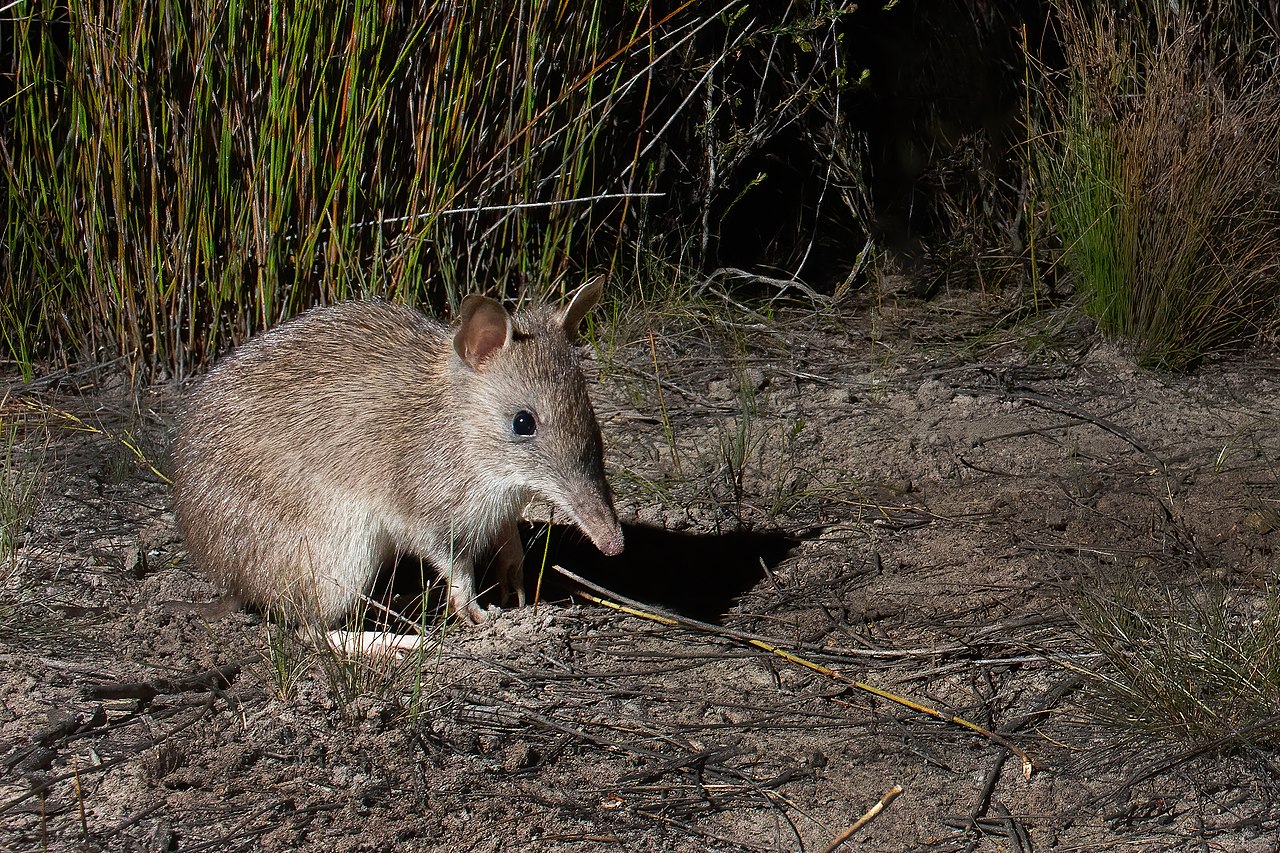
Long-nosed Bandicoot, northern beaches, New South Wales. Photo: JJ Harrison
The Southern brown bandicoot (Isoodon obesulus) is listed as endangered in NSW. It is around 28–36 cm in size and weighs up to 1.5 kg. It has small, rounded ears, a longish, conical snout, a short, tapered tail and a yellow-brown or dark grey coat with a cream-white underbelly. They are smaller and shyer than other species and do not stray far from their preferred shelter of dense heath vegetation.
The southern brown bandicoot is patchily distributed and occurs south from the Hawkesbury River to the Victorian border and east of the Great Dividing Range.
There are 2 main populations; one lives in Garigal and Ku-ring-gai Chase national parks in northern Sydney - yet more reason to keep pets out of these places. The other lives around Ben Boyd National Park and Nadgee Nature Reserve in the far south-eastern corner of the state.
Southern brown bandicoots are nocturnal and omnivorous, feeding on insects, spiders, worms, plant roots, ferns, and fungi. Gestation lasts less than fifteen days and typically results in the birth of two or three young.
The young weigh just 350 mg (5.4 gr) at birth, remain in the pouch for about the first 53 days of life, and are fully weaned at around 60 days. Growth and maturation is relatively rapid among marsupials, with females becoming sexually mature at four to five months of age, and males at six or seven months. Lifespan in the wild is probably no more than four years.
Populations have declined markedly and become much more fragmented in the time since European expansion on the Australian mainland, much of that due to the clearing of habitat. In many areas of its range the species is threatened locally, while it may be common where rainfall is high enough and vegetation cover is thick enough. Apart from habitat fragmentation, the species is under pressure from introduced predators such as the red fox and feral cats. It has been reintroduced to some lower rainfall areas where there is protection against cat and fox predation – one such site being Wadderin Sanctuary in the eastern wheatbelt of Western Australia, 300 km east of Perth.
In national assessment, the southern brown bandicoot is currently regarded as Endangered on the mainland as a whole, and Vulnerable in South Australia.
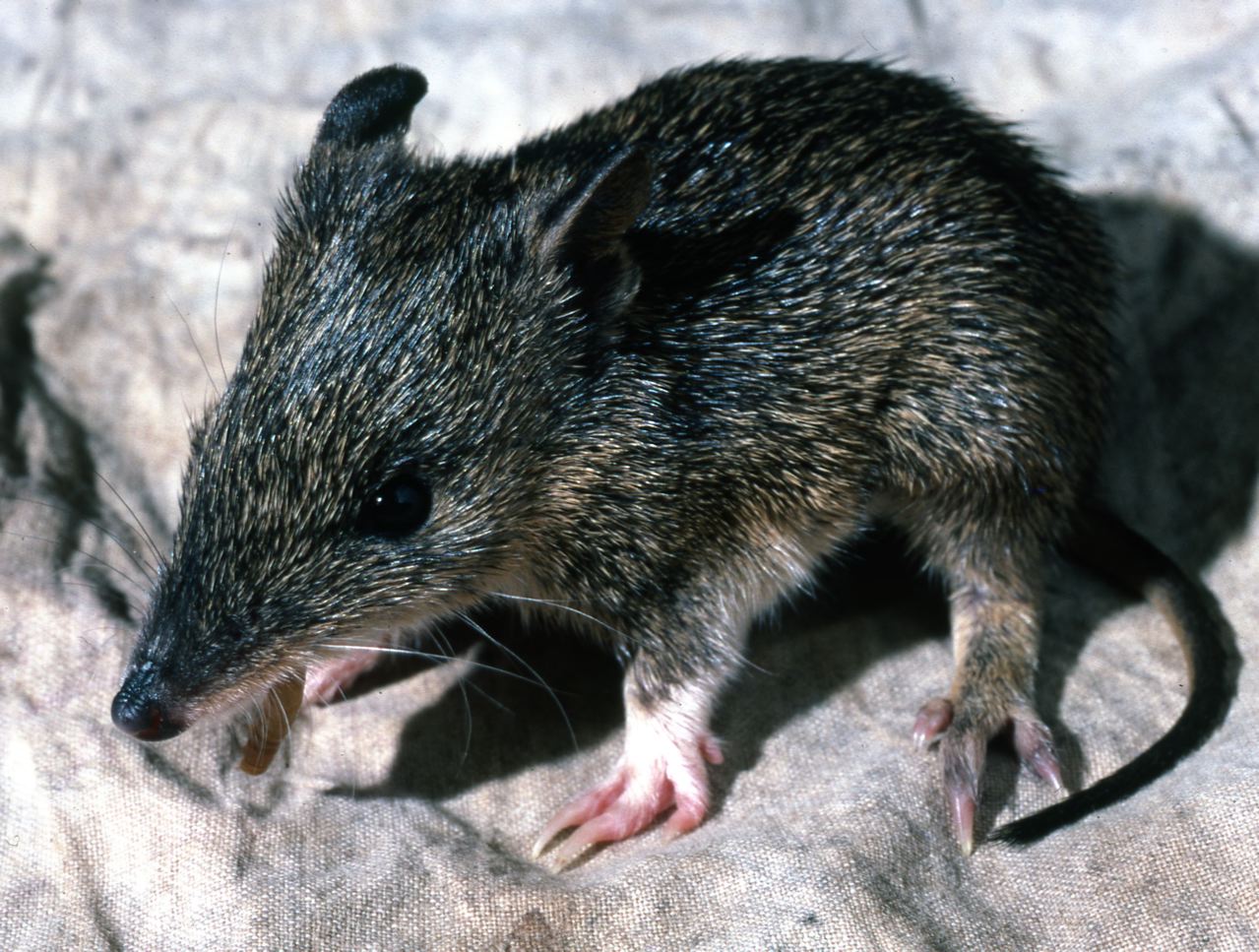
Juvenile southern brown bandicoot. Photo; Bertram Lobert
Bandicoots have at least 4 distinct vocalisations:
- a high-pitched, bird-like noise used to locate one another
- when irritated, they will make a 'whuff, whuff' noise
- when feeling threatened or alarmed, they will make a loud 'chuff, chuff' noise and loud whistling squeak at the same time
- when in pain or experiencing fear, they will make a loud shriek.
Activities to assist this species:
- Prevent domestic cats and dogs from roaming into habitat areas.
- Protect all known and potential habitat and include linkages across the broader landscape.
- Undertake fox, feral dog and feral cat control programs.
- Apply fire regimes that maintain patches of dense ground cover and floristic and structural diversity in the habitat.
Helen Pearce
Bilgola Plateau
Sydney Wildlife Rescue And Rehabilitator, Busy Mum
What is your favourite local wildlife species?
This question is HARD as I struggle to find a favourite species and one which highlights their plight with the general public. I have always loved animals from as long as I can remember and my family have always been involved in animal rescue work. However, I guess for ease, I'll have to say the Brushtail Possum
Why do you like Brushtail Possums so much?
Very soon after I had done the RCC (Rescue and Care Course) with Sydney Wildlife Rescue (SWR), I did the baby possum course, which allowed me to care for and raise possum joeys. Being so close to national park, we get heaps of these little guys in due to car strike and being urban, dog and cat attacks. I started off with a couple of older possums, they were about 400g so still on specialised marsupial milk, but also eating foliage and were pretty easy to care for. By this stage, they are starting to 'wild up' and it was very hands off. Once released, I was able to care for smaller joeys and, with very close guidance from an experience carer within SWR, I took on a 90 to 100g joey. These are hairless, eyes closed and totally dependent on you. He was on 6 feeds a day and needed constant heat to survive. I loved it! Once they open their eyes and they see you, I fall in love with each and every one. Their dark eyes look deep into your soul and the hold eye contact during feeds, just like a human baby.
There's a lot of people out there who hate brushies because they're loud/annoying/eat people's plants/toilet places they don't want/live in roofs/annoy their dog at night.......etc., etc., etc. But people need to realise how much land and trees we've taken away and that these beautiful creatures have no choice. They're just trying to survive, like every other living thing on this broken planet we all have to share. If there's a possum in your roof its because there's nowhere else for it to go. Put up a possum box and that helps (and fix your roof!) and leave some trees up....that will help with heat issues too. You can train your dog to not be reactive to them and you can learn to appreciate their beauty.
I took a break for a couple of years in 2018 so I could raise my own human joey, but now I'm back at it in full force. At 5 years old, my son is also in love with wildlife care and loves naming the joeys we get in. We currently have 4 joeys in care and he's learning the ropes, ready for his 18th birthday when he too, can become a licensed wildlife rescuer, like his mum and dad.
How long have seen or heard this animal?
I have been rescuing and caring for them since 2012. We have many local possums, both Ringtails and Brushtails and have supplied boxes and dreys for them in the bush area outside our house. We are lucky enough to have a creak with some bush which are [perfect for them to connect to other areas of the community bush highway. By providing homes here, it not only helps them out, but hopefully keeps them out of unwanted areas.
Have you noticed any changes in the number of these animals in your local neighbourhood?
Possums are a hardy species, they have to be. I think it's stayed pretty constant over the last 10+ years in our area. However, I have noticed more animals coming in with Exudative Dermatitis, also known as Stress Dermatitis, which is a result of a number of factors, such as lack of home, reduced habitat, and shortness of adequate food sources....that's our human impact again. I actually have a mother and joey in at the moment suffering from this. The kind member of the public notified me that there was an adult possum with blood on it's leg and, upon attendance, found a mother with her 400g joey. Both were out during the day, petrified and the mother was feeling sick and in pain. I trapped them and had them seen at the SWR Mobile Care Unit where our amazing volunteer vets gave me antibiotics for her. She's now ready for release back into the wild.
An adult possum bought into care MUST, by law and ethics, go back within 50m of where it was found, it can be a death sentence for them if they are not taken back to their home range. Joeys raised in care can be released in other areas as they have no territory in the first place, so I release in trusted locations, as far away from humans as I can, so they can have a, hopefully, better and more natural life. But we never really know and that's very sad. I often think of my previous releasees.
Helen
Brushies Information
There have been 7,118 possums rescued in our LGA area from June 2013 to June 2021, 1,978 were released.
There have been 3.351 cuscus and possums rescued in our LGA area from June 2013 to June 2021, 820 were re-released.
There have been 20 Eastern Pygmy possums and Feathertail gliders rescued acrsoss the LGA - habitat alteration and tree felling has caused the bulk of rescues, and in 2015 to 2017 was the highest occurrence. Of those rescued just 14 were released.
A tiny shy nocturnal possum, these are not always found before a tree is cut down and would not be seen among the debris.
For the cus cus collisions with with motor vehciles is listed as the most common reason for rescue, followed by 'unsuitable environment' (in someone's roof for example), and then 'parent taken into care' - due to cat attack, 96 of these in 2020/2021 alone, or 'fallen from nest' - a spring time dilemma - 158 of these in 2020/2021 and one that would account for many of those re-released.
Brushies 'fell from nest' into 60 rescues during 2020/2021, there were 39 recorded attacks by a cat, 14 'rescued' due to being in an unsuitbale enviroment - rooves, trees that are about to be cut down - and 10 which had been hit by a car.
It's importnat to remember that those rescued due to being 'hit by a car' is not the same as those who could not be rescued because they have been killed by a car. More on those statsics soon.
Cuscus is the common name generally given to the species within the four genera of Australasian possum of the family Phalangeridae with the most tropical distribution:
- Ailurops
- Phalanger
- Spilocuscus
- Strigocuscus
Locally we also have the Pygmy Possum and a project that commenced in May 2015 in our offshore community as a monitoring program to establish data on the location, frequency and seasonal movements of the Eastern Pygmy Possum on the Western Shores of Pittwater. Other visitors to the nesting boxes, such as Feather-tailed Gliders and Antechinus, are also recorded.
The funding applicant, Rocky Point Bushcare, was provided with mini grant of $1500, awarded by Greater Sydney Local Land Services, to fund the purchase of 2 high quality wildlife cameras and backed by Pittwater Council, the Pittwater Natural Heritage Association (PNHA), and local state member Rob Stokes.
Twenty-nine nesting boxes were purchased by residents and placed at the back of properties throughout Elvina Bay, Lovett Bay and Towlers Bay.
The common brushtail possum (Trichosurus vulpecula, from the Greek for "furry tailed" and the Latin for "little fox", previously in the genus Phalangista) is a nocturnal, semiarboreal marsupial of the family Phalangeridae, native to Australia.
The common brushtail possum is largely arboreal and nocturnal. The common brushtail possum can breed at any time of the year, but breeding tends to peak in spring, from September to November, and in autumn, from March to May, in some areas. A newborn brushtail possum is only 1.5 cm long and weighs only 2 g. As usual for marsupials, the newborn may climb, unaided, through the female's fur and into the pouch and attach to a teat. The young develops and remains inside the mother's pouch for another 4–5 months. When older, the young is left in the den or rides on its mother's back until it is 7–9 months old. Brushtail possums can live up to 13 years in the wild.
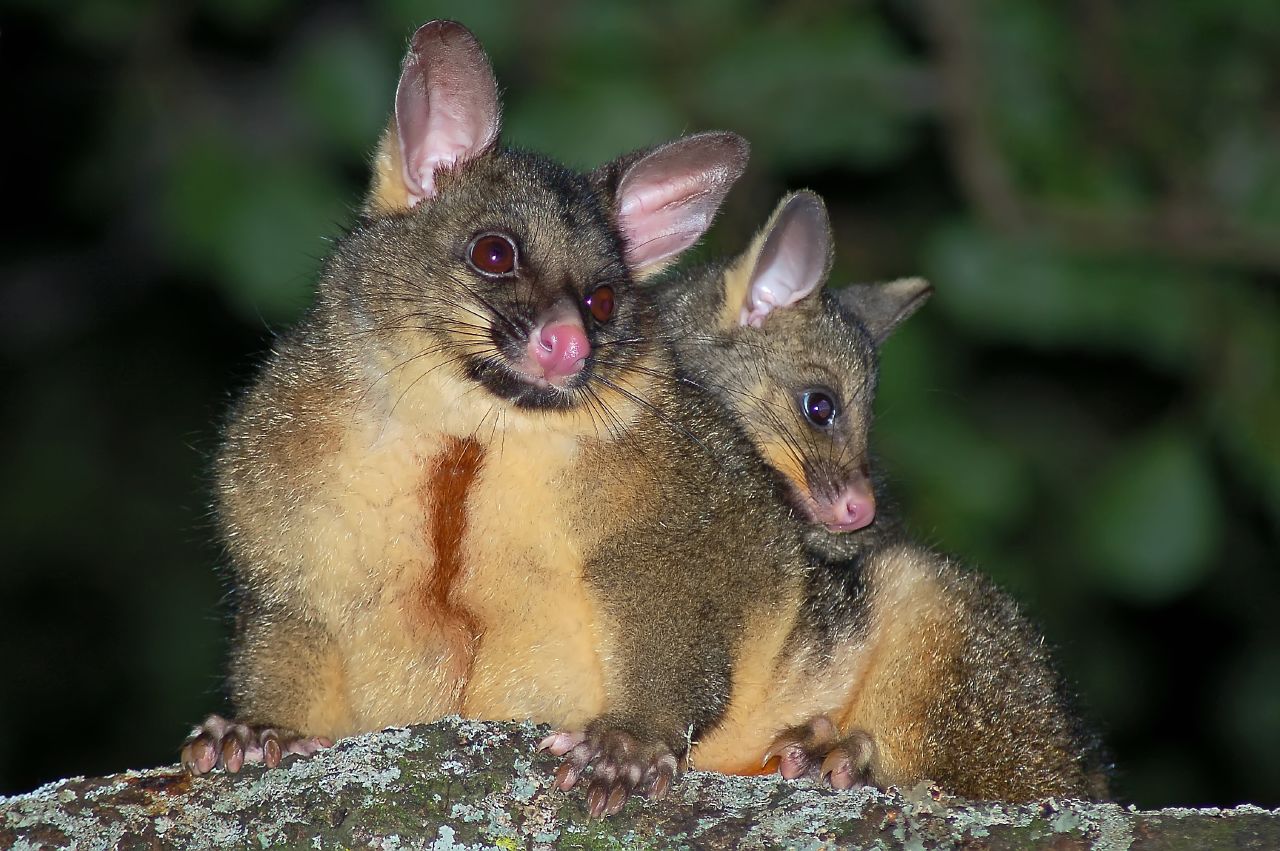
Brushtail possum with young. Photo: Bryce McQuillan
Although once hunted extensively for its fur in Australia, the common brushtail possum is now protected in mainland states, but it has only been partially protected in Tasmania, where an annual hunting season is used. In addition, Tasmania gives crop-protection permits to landowners whose property has been damaged.
Populations of all these species are declining in due to habitat loss and cats that are allowed to be outdoors at night and attack them.
The Brushie has a mostly solitary lifestyle, and individuals keep their distance with scent markings (urinating) and vocalisations. They usually make their dens in natural places such as tree hollows and caves, but also use spaces in the roofs of houses.
Brushtail possums compete with each other and other animals for den spaces, and this contributes to their mortality, as does removing them from rooves and dumping them in the bush - here too they will meet other brushtail possums that will chase them off. Brushies are also particular about what they eat and like the taste of what grows in their home grounds - dumping will lead to starvation.
These too, are not so 'common' anymore.
Amina Kitching
Elvina Bay
WIRES Wildlife Rescuer And Rehabilitator
What is your favourite local wildlife species?
That’s hard; I do like the goannas, the magpies and lately the echidna, because I’ve been able to see one that visits our home, and I do really like the possums as well. But my favourite?; its probably the goannas’.
Why do you like the goannas?
I was always quite terrified of them but I ha the opportunity to rehabilitate one and get to know them a bit better. They don’t mean to come off so aggressive, it’s just how they behave within their own hierarchy. When they come at you they’re not trying to attack you – they’re really inquisitive. Having handled a small one, and it’s never to bond with native wildlife whatsoever, people feeding them is not good, it’s not good for their health of their entire species community, I had a really hard time trying to get this goanna to leave us.
How long have you encountered goannas?
My whole life. We had them growing up on the property and living there beside us. As a child I remember barbecues on the beach at Portuguese and how I would go and sit half up a cliff face just to eat my sausage sandwich in peace. They literally would just rush you and take I out of you hand. I’m only little, still not that tall, and at a young age I was only tiny – so they were bigger than me.
Have you noticed any changes in the numbers or frequency of goannas in your neighbourhood?
There’s probably more babies around than I ever recall. At times at Elvina Bay we’ve had packs of six adult ones all around the house. I was trying to scare them away as we had chickens and guinea pigs as well as other wildlife rescue species. So we had to be careful with that as those are food in the cage for them.
Do now, back at Lovett Bay I’m spreading them out so we’re not creating a hub for them. It is intimidating having half a dozen goannas, or even one or two trying to interfere with your day to day living or rehabilitation of wildlife.
When did you become a WIRES Rescue and Rehabilitator?
About 2 to 3 years ago. Growing up I did it with my neighbour, she ran an entire wildlife rehabilitation centre out of her backyard. He had everything – and this is where I got a lot of the training from initially. It’s one thing learning it but then having hands on experience is completely different.
A short while ago we ran your appeal asking people to look out for and after Pittwater’s turtles by sticking to the speed limit and zones. Why is this imporant?
Yes, people are going too close to the poles – they’re meant to be 30 metres form the pole and if they’re 30 metres form the pole hey would be effectively out of the zone where the turtles come up to breathe every half an hour. So it’s really important for people to just do this simple thing and look after the turtles we have in the estuary.
Why did you take this on – you’re a mum, an entrepreneur who runs her own highly successful business – why was it important to you?
It was important because where I live is boat access only and there was no WIRES representative with a boat. So that meant that every time someone in the area called in for help here would be nobody available to go because it’s boat access only. So the only option people had was to call the police to put the animal down, or call the vet who may take hours to days to get there.
Originally when I was a teenager I wanted to be a Vet but I got a scholarship to do Design, and living in a creative family and I thought ‘I’ll go with what’s there’. In o family we do have a lot of doctors, nurses, surgeons and all of that – so none of that fazed me at all, and I did do all the preliminary training for veterinary work, but what put me off was so many of the animals being euthanised all the time. It’s 2 out of 3, perhaps even more.
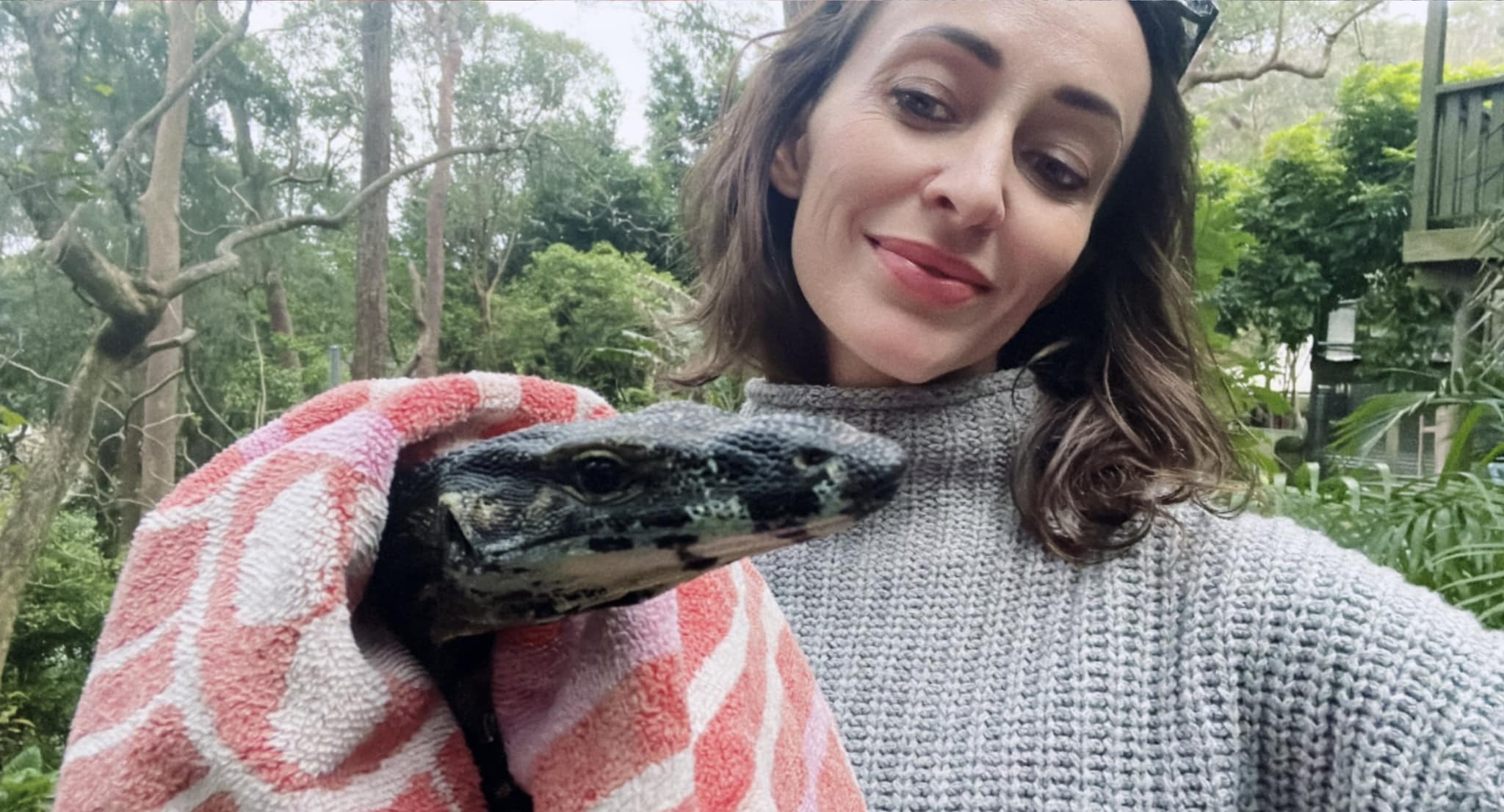
Amina with Go-go, the young goanna she nursed back to health.
The lace monitor (Varanus varius), also known as the tree goanna, is a member of the monitor lizard family native to eastern Australia. A large lizard, it can reach 2 metres (6.6 ft) in total length and 14 kilograms (31 lb) in weight.
A goanna is any of several Australian monitor lizards of the genus Varanus, as well as certain species from Southeast Asia. Around 30 species of goanna are known, 25 of which are found in Australia. This varied group of carnivorous reptiles ranges greatly in size and fills several ecological niches.
The goanna features prominently in Aboriginal mythology and Australian folklore. Being predatory lizards, goannas are often quite large, or at least bulky, with sharp teeth and claws. The largest is the perentie (V. giganteus), which can grow over 2.5 m (8.2 ft) in length.
Not all goannas are gargantuan. Pygmy goannas may be smaller than a man's arm. The smallest of these, the short-tailed monitor (Varanus brevicuda) reaches only 20 cm (8 inches) in length. They survive on smaller prey, such as insects and mice.
Goannas combine predatory and scavenging behaviours. A goanna will prey on any animal it can catch and is small enough to eat whole. Goannas have been blamed for the death of sheep by farmers, though most likely erroneously, as goannas are also eaters of carrion and are attracted to rotting meat.
Most goannas are dark-coloured, with greys, browns, blacks and greens featuring prominently; however, white is also common. Many desert-dwelling species also feature yellow-red tones. Camouflage ranges from bands and stripes to splotches, speckles, and circles, and can change as the creature matures, with juveniles sometimes being brighter than adults.
Like most lizards, goannas lay eggs. Most lay eggs in a nest or burrow, but some species lay their eggs inside termite mounds. This offers protection and incubation; additionally, the termites may provide a meal for the young as they hatch. Unlike some other species of lizards, goannas do not have the ability to regrow limbs or tails.
A field study in Burragorang, New South Wales found that males over 5 kg ranged over home territories of 65.5 ± 10.0 hectares. They moved around much less in winter.
In at least the temperate regions, the breeding season takes place in the summer. Male lace monitors fight each other by grappling while standing on the hind legs in the breeding season, and up to six males may gather around a receptive female to try and court her. Mating takes several hours. Females lay an average of eight eggs in active termite nests either on the ground or in the trees, although they may lay as many as 12 eggs. When such nests are in short supply, females often fight over them or lay the eggs in burrows and perhaps hollow logs. The eggs overwinter to hatch 6–7 months later. Hatchlings remain around the nest for about a week or more before leaving its vicinity. Females may return to the same termite nest to lay their next clutch of eggs. These monitors can potentially live to reach over 20 years of age.
There have been 116 Gould's Goanna, Rosenberg's Goanna and Lace Monitors rescue in our area during the whole June 2013- June 2022 data period for the LGA, 1 a threatened species, and just 45 released. Although this total is not at high as the 465 Australian Dragon species rescued, 161 released, the Lace Monitor, or tree goanna has the highest total number of rescues with 'collisions with motor vehicles' again listed as the primary cause of injury and death.
David Goudie
North Avalon
Director, Blue Swimmer Group Australia
What is your favourite local wildlife species?
Ringtails / bandicoots / owls (sorry, can’t split these!).
Why do you like this species?
Their character / natural beauty / vulnerability
How long have seen or heard this animal?
I saw a ringtail last night but becoming rarer (was a roaming cat following it!!! which I chased off). Saw a bandicoot at a friends place 3 weeks ago but worryingly not in our area (north Avalon) for maybe a year now - used to see lots. I hear owls at night but haven’t see one for a long time.
Have you noticed any changes in the number of these animals in your local neighbourhood?
Yes, absolutely (down). As per my previous answer
David
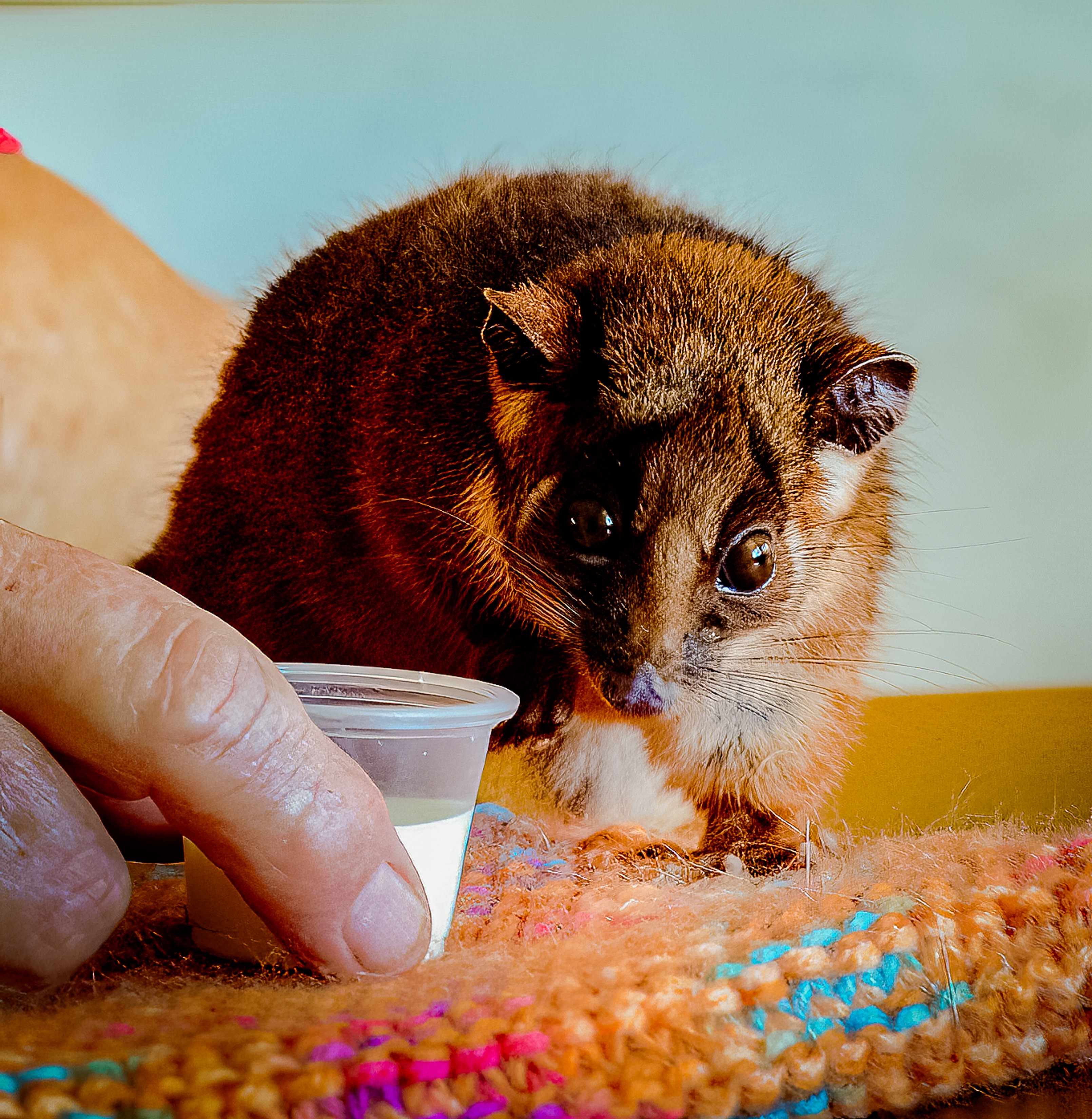
Baby Ringtail in care. Photo: Michael Mannington OAM
The data collected by the NSW Department of the Environment states 50, 500 Ringtail possums have been rescued across NSW during the June 2013 to June 2021 period, the bulk of this in and around Sydney, and 12, 724 released.
In this LGA a total of 7, 118 have been rescued and 1, 978 released.
'Fallen from nest or tree' is listed as the primary cause of rescues in this area, especially during the 2017-18 and 2020 to 2021 years. Cat attacks is listed as the second primary cause of rescues and fatalities.
In 2020 to 2021 994 were rescued in this LGA and 348 released - 646 died as a result of their injuries or being thrown from their homes. Clearing habitat – the trees and underbrush they live and nest in, is what is killing these other residents - with 'abandoned/orphaned' and 'fallen from tree or nest' again listed as the primary causes during 2020-21, followed by attacks by domestic cats.
Because they are largely arboreal, common ringtail possums are particularly impacted by deforestation in Australia at an urban and rural scale. They are also heavily predated upon by the introduced red fox. They are also hit by cars, or killed by snakes, and cats and dogs in suburban areas.
Ringtail possums (Pseudocheirus peregrinus), referred to as 'common ringtail possums' despite them not being so common anymore, weighs between 550 and 1,100 g (19 and 39 oz) and is approximately 30–35 cm (12–14 in) cm long when grown (excluding the tail, which is roughly the same length again). It has grey or black fur with white patches behind the eyes and usually a cream-coloured belly. It has a long prehensile tail which normally displays a distinctive white tip over 25% of its length. The back feet are syndactyl, which helps it to climb. The ringtail possum's molars have sharp and pointed cusps.
Common ringtail possums live a gregarious lifestyle which centres on their communal nests, also called dreys. Ringtail possums build nests from tree branches and occasionally use tree hollows. A communal nest is made up of an adult female and an adult male, their dependant offspring and immature offspring of the previous year. A group of ringtail possums may build several dreys at different sites. Ringtail possums are territorial and will drive away any strange conspecifics from their nests. A group has a strong attachment to their site. In one experiment, in which a group was removed from their territory, it remained uncolonised for the following two years. Ringtail possum nests tend to be more common in low scrub and less common in heavily timbered areas with little under-story. Dreys contribute to the survival of the young when they are no longer carried on their mother's back.
The ringtail possum carries its young in a pouch, where it develops. Depending on the area, the mating season can take place anywhere between April and December. The majority of the young are born between May and July. The oestrous cycle of ringtail possum lasts 28 days. It is both polyoestrous and polyovular. If a female prematurely loses her litter, she can return to oestrous and produce a second litter in October as a replacement if conditions are right. The average litter is two, although there are very occasionally triplets. Common ringtail possum young tend to grow relatively slowly due to dilute milk with low lipid levels that is provided to the young. As with other marsupials, the common ringtail possum's milk changes through lactation. During the second phase of lactation, more solid foods are eaten, especially when the young first emerges from the pouch. During this time, the concentration of carbohydrates fall, while those of proteins and lipids reach their highest. The long lactation of the ringtail possums may give the young more time to learn skills in the communal nest as well as to climb and forage in the trees. The young are first able to vocalise and open their eyes between 90 and 106 days of age. They leave their mother's pouch at 120–130 days. However, lactation usually continues until 180–220 days after birth but sometimes ends by 145 days.
Unfortunately we are losing a lot of our local owls and Tawny Frogmouths to rat poisons, along with other species of raptors and even kookaburras.
At the October 2022 Council Meeting Cr. Glanville put up a motion for council to phase out the use of all anticoagulant rat poisons by April this year, along with reporting by May on the use of herbicides, fungicides, pesticides, insecticides, rodenticides and chemical management of vertebrate animals. Ms Glanville accepted an amendment for staff to brief councillors within four weeks on the environmental and financial costs and benefits of using SGARS or alternatives and the feasibility of phasing out their use amongst Council contractors. At the November 2022 Council Meeting it was Resolved that Council:
1. Council phase out use of Second-generation Anticoagulant Rodenticides (SGARs) on land owned or managed by Council.
2. The Chief Executive Officer report back to Council by August 2023:
A. progress of the phase out of SGARs by Council and relevant third parties (eg suppliers, contractors, tenants)
B. considerations as to usage of other chemicals on Council lands that may pose environment or human health risks
C. available alternative methods and implications for Council.
3. Council seek opportunities to further educate the community regarding SGARs and other harmful chemicals and recommendations for safe alternatives.
No Report and nothing else on this subject was listed for the August 2023 Council Agenda. Concerned residents can contact Cr. Glanville and their other representatives on what progress council has made and when the Report on progress to phase these deadly chemicals has been made.
Addresses were given on this subject by Birdlife Australia’s Urban Bird program coordinator, Dr Annie Naimo, and wildlife carer and retired toxicologist Edwina Laginestra at that October 2022 Meeting. These run as follows:
My name is Edwina Laginestra, I’m a local wildlife carer, and retired-scientist specialising in toxicology
Rodenticides – both first generation and second generation anti coagulants – are used to kill “pest rodents” but increasingly it is harming our wildlife. Especially in winter, many unwanted creatures come into our homes and other buildings for warmth and food. People see ratbait as an easy and out-of-mind solution but don’t generally think about other impacts. Our wildlife is affected both directly (as I have treated both brushtail possums and blue tongue lizards for ratbait) and indirectly (as predators such as raptors eat the baited rodents which are sick and an easy catch and have residual poison concentrations). Many pets are also affected. SGARs have been banned in other countries due to longevity in the environment.
Treating baited wildlife is horrific and most do NOT survive. Rodents take around 3 to 9 days to die, but animals with slower metabolisms, such as our marsupials, take longer. Regarding SGARs it takes 14 days for symptoms to show in a possum and 21 days for it to die (from NZ research). If we can get it early we have a chance and have to treat the possum for 6-8 weeks (volunteer carers pay for treatment, and vets may charge us at cost only). However, sometimes we do not know what we are dealing with and by the time the symptoms show it is too late. I have treated well over a dozen brushtail possums. I think only 3 survived – 2 were young and OK with treatment in captivity. One was an adult male who was in care for 3 months – ratbait treatment then physio and containment for regaining muscle strength. The Koagulon he was treated with cost $150. Often we get in a beautiful mum that has been baited and have to try and save the joey that may already be bleeding internally.
Earlier this year I picked up a beautiful barn owl that was sitting in the middle of Seaforth Oval – a dog had attacked it even though the owner was quick to realise what was happening. But the owl was now badly injured. Why could the dog attack it and break a wing and pelvis? Because it was already unwell with eating baited rodents. What an horrific end of life. We have been picking up boobooks and Tawny Frogmouths that were likely baited but it is only recently there has been funding to test for harmful chemicals.
I have also picked up many ringtail possums that have eaten tips of freshly sprayed hedges. They foam at the mouth and spin as they die (which can take more than 8 hours). I spoke to Yates about systemic treatments in some plants for psyllids. They felt the poison may be active within the plant (and leaves) for up to 6 months. So although ringtail possums rarely take SGARs, they are very vulnerable to herbicides. However yesterday I had a ringtail die suddenly – he’d been in care for 5 days, but suddenly he was very thirsty and dizzy. I administered fluids and antibiotics (as he’d had surgery) but he died with blood coming out of his nose, paws and abdomen. He was probably already dying for a week before coming into care. He may have eaten bait due to habitat and food loss.
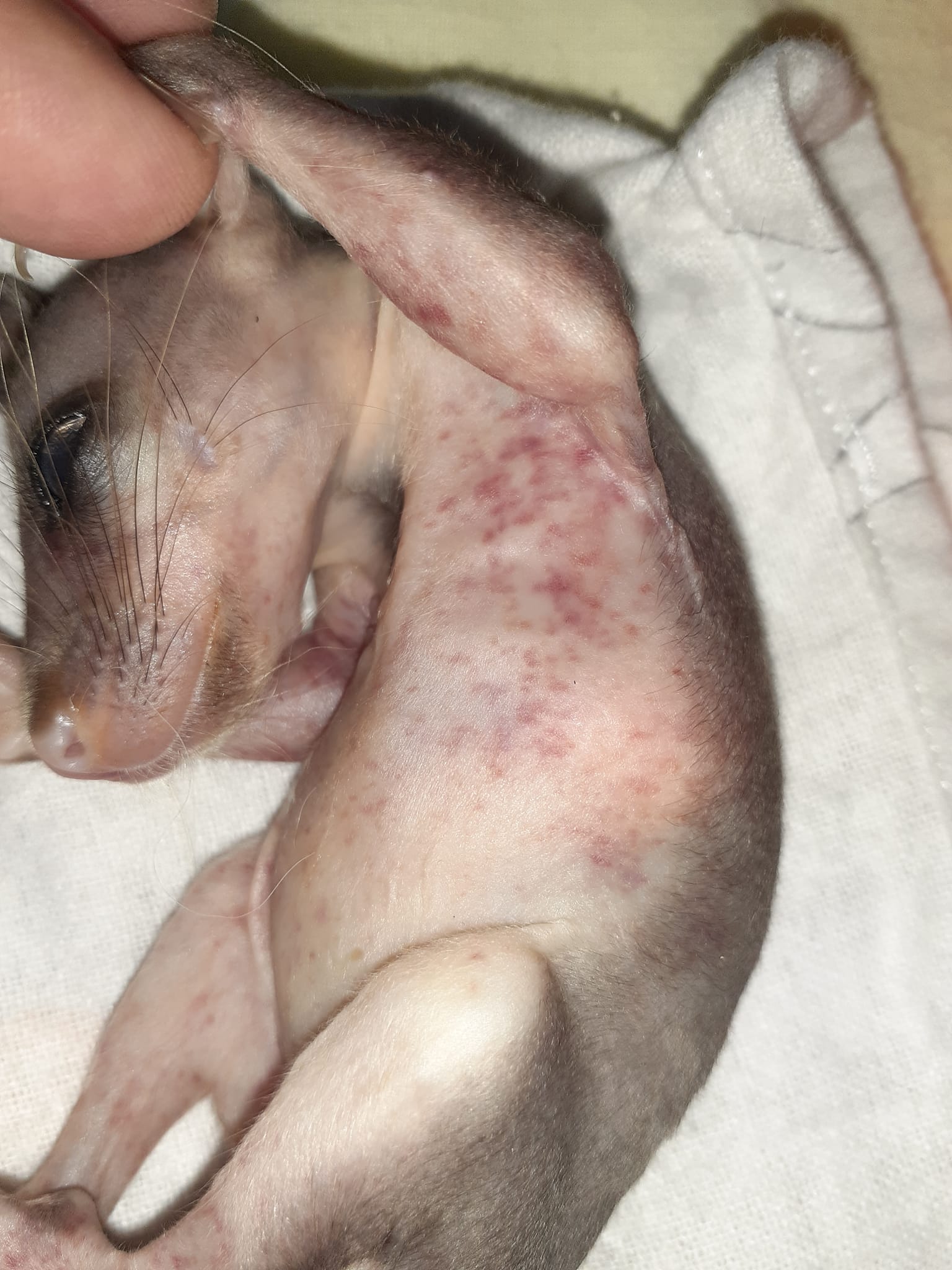
Photo: brushtail joey un-emerged rodenticide, image supplied
Wildlife carers are the volunteers that spend the most money on their volunteering. We also already have quite a number of patients already in care. Giving drugs and physio adds extra time to our care load. We also spend time taking them to the vet who are also pressed for time and often treat wildlife for free. Sometimes we simply do not know what we are dealing with and administer treatment too late or incorrectly and we can make symptoms worse. This causes great anxiety as well. If there are actions others can take to avoid wildlife coming into care that would be most helpful – regarding pest management there are many other options in the cities – including the natural pest management our wildlife provides. Watching an animal get worse and die in care is tough emotionally and physically.
Barn Owl that died from Ratbait secondary poisoning. Image supplied
Dr Annie Naimo, Urban Bird Program Coordinator, BirdLife Australia
I’m writing on behalf of BirdLife Australia to support your motion to phase out the use of Second-generation Anticoagulant Rodenticides (SGARs).
BirdLife Australia is an independent non-partisan science-based bird conservation charity with over 300,000 supporters. Our primary objective is to conserve and protect Australia’s native birds and their habitat. We are the national partner of BirdLife International, the world’s largest conservation partnership.
Second-generation anticoagulants pose an extreme threat to native birds and wildlife. SGARs take several days to kill pests, and in this time accumulate in the body of poisoned animals.
SGARs persist in the body for a long duration, and in carcasses after death- posing additional risk to wildlife that may prey upon poisoned animals.
In greater Sydney, research undertaken by BirdLife Australia has found fatal levels of SGARs in dead Powerful Owls, a vulnerable species. Further Australian studies have shown similar fatal levels of SGARs in other birds of prey, such as Southern Boobooks and Wedge-tailed Eagles.
Other Australian wildlife are also at risk and have had documented instances of SGAR poisoning, including marsupials, native rodents, and reptiles, as well as pet cats and dogs.
Because of the clear evidence and risks, SGARs have been heavily regulated in Europe, Canada, and the USA. Many other local governments areas in NSW are already phasing out SGARs in their community, including Randwick, Wollongong, Tweed Shire, Port Macquarie-Hastings and Kiama.
Importantly, there are alternative pest control products available (e.g. first-generation anticoagulant rodenticides, non-anticoagulant rodenticides including cholecalciferol) that are similarly as effective as SGARs, but pose significantly less environmental risk when administered correctly.
To support you in your transition away from SGARs, BirdLife Australia has developed an Action Kit for Councils. The Action Kit details how SGARs threaten wildlife and pets, provides effective ways that councils can move to alternative pest control methods, and includes links to additional resources to help you to keep your local community safe.
There is also a BirdLife Australia Open Letter you can add your name to. This calls for government Ministers to help get dangerous Second-generation Anticoagulant Rodenticides regulated properly in Australia. More at: www.actforbirds.org/ratpoison
In our LGA 103 Tawny Frogmouths have been rescued and 29 released in the June 2020 to June 2021 data period alone - 861 have been rescued and just 222 released over the whole of the June 2013 to June 2021 data period recorded - which may not be as accurate as hoped - as explained above, and also list a further 461 'unidentified' birds that have been rescued and a further 16 'dependent young' without a species classification allocated.
Collisions with motor vehicles and ‘unsuitable environment’ are listed as the primary reasons for the birds coming into care. Disease, listed as an ‘internal parasite’ is also listed. Obviously deaths from poisons needs to be added to causes of mortalities.
Tawny frogmouths will often perch at the sides of roads where streetlights attract moths. Another reason to slow down on our local roads.
The tawny frogmouth (Podargus strigoides) is a species of frogmouth native to the Australian mainland and Tasmania and found throughout. It is a big-headed, stocky bird, often mistaken for an owl, due to its nocturnal habits and similar colouring, and sometimes, at least archaically, referred to as mopoke, a name also used for the Australian boobook, the call of which is often confused with that of the tawny frogmouth.
Tawny frogmouths are carnivorous and are considered to be among Australia's most effective pest-control birds, as their diet consists largely of species regarded as vermin or pests in houses, farms, and gardens. The bulk of their diet is composed of large nocturnal insects, such as moths, as well as spiders, worms, slugs, and snails but also includes a variety of bugs, beetles, wasps, ants, centipedes, millipedes, and scorpions. Large numbers of invertebrates are consumed to make up sufficient biomass, as are reptiles and frogs, and birds.
The conservation status of tawny frogmouths is "least concern" due to their widespread distribution. However, a number of ongoing threats to the health of the population are known. Many bird and mammalian carnivores are known to prey upon the tawny frogmouth. Native birds, including ravens, butcherbirds, and currawongs, may attempt to steal the protein-rich eggs to feed their own young. Birds of prey such as hobbies and falcons, as well as rodents and tree-climbing snakes, also cause major damage to the clutches by taking eggs and nestlings. In subtropical areas where food is available throughout the year, tawny frogmouths sometimes start brooding earlier in winter to avoid the awakening of snakes after brumation. Since 1998, a cluster of cases of neurological disease has occurred in tawny frogmouths in the Sydney area, caused by the parasite Angiostrongylus cantonensis, a rat lungworm.
2 biggest threats to wombats revealed in new data gathered by citizen scientists
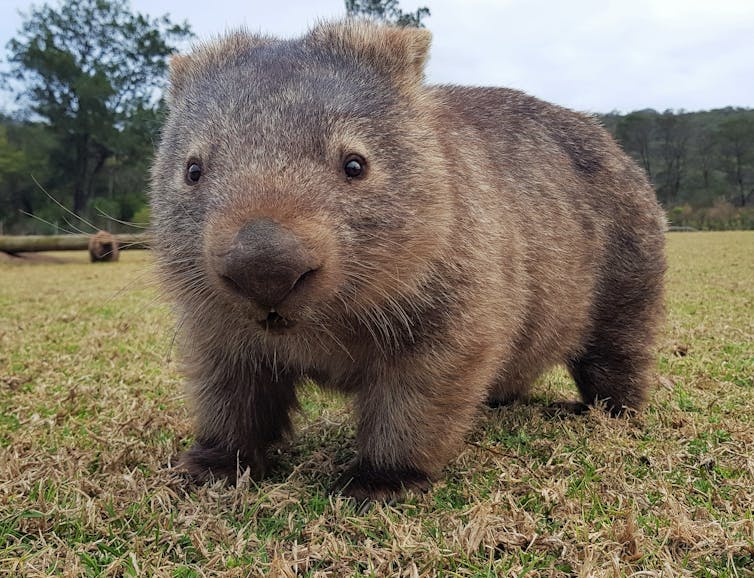
Launched in 2015, WomSAT (Wombat Survey and Analysis Tool) is a citizen science project and website that allows “wombat warriors” to report sightings of wombats, their burrows, and even their cube-shaped poops.
The project initially aimed to uncover information on all things wombat from across Australia, particularly threats. Its ultimate aim is to support conservation, informed by an enhanced understanding of wombat biology.
WomSAT also aims to educate the wider community by using the hashtag #WombatWednesday to spread the word. The project has resulted in raising the profile of wombats in the broader community.
People have jumped onboard to support the charismatic species, and thousands of posts have been shared via social media.
To date, citizen scientists across Australia have reported more than 23,000 wombat sightings to WomSAT. These sightings have recently been analysed and the findings published in Australian Mammalogy and Integrative Zoology.
Importantly, the data have given us new insights into where to find two of the biggest threats: Australia’s wombat roadkill hotspots, and the worst areas for sarcoptic mange (a disease related to scabies).
Making Our Roads Safer For Wombats
Wombats are large, mostly grass-eating native Australian marsupials. They play an essential role in maintaining biodiversity as ecological engineers. Through their burrowing, they maintain soil health and create habitat to support other plants and animals.
There are three species of wombats: the critically endangered northern hairy-nosed wombat (Lasiorhinus krefftii), the threatened southern hairy-nosed wombat (L. latifrons), and the bare-nosed or common wombat (Vombatus ursinus).
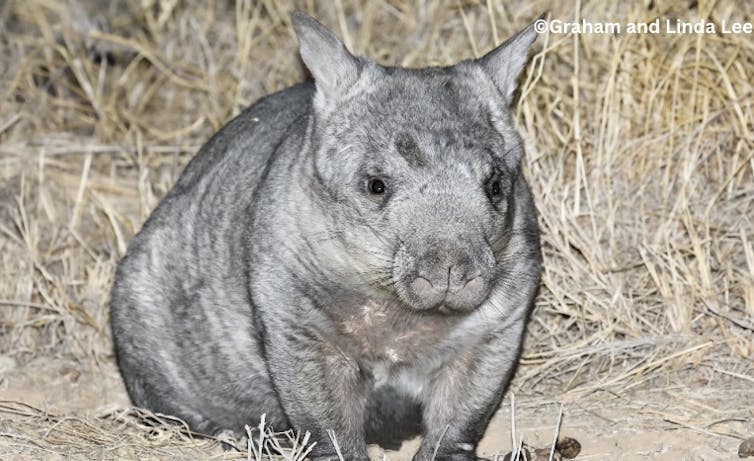
Like most Australian native animals, wombats are under threat on many different fronts – habitat destruction, changed fire regimes, competition from introduced species, and even direct persecution by humans, as they are deemed pests by some. The bare-nosed wombat is particularly impacted by roadkill and sarcoptic mange.
The new data reported to WomSAT have identified roadkill hotspots and factors affecting wombat vehicle collisions. Several areas were identified as roadkill hotspots, including Old Bega Road and Steeple Flat Road in southern New South Wales. Most wombat roadkill deaths occurred in winter, and sadly most appeared otherwise healthy.
Having better data and identifying these roadkill hotspots will ultimately reduce road risks for people and wombats. We can target these hotspots using mitigation strategies such as reduced speeds, signage and barriers to prevent wombat crossing and avoid collisions.
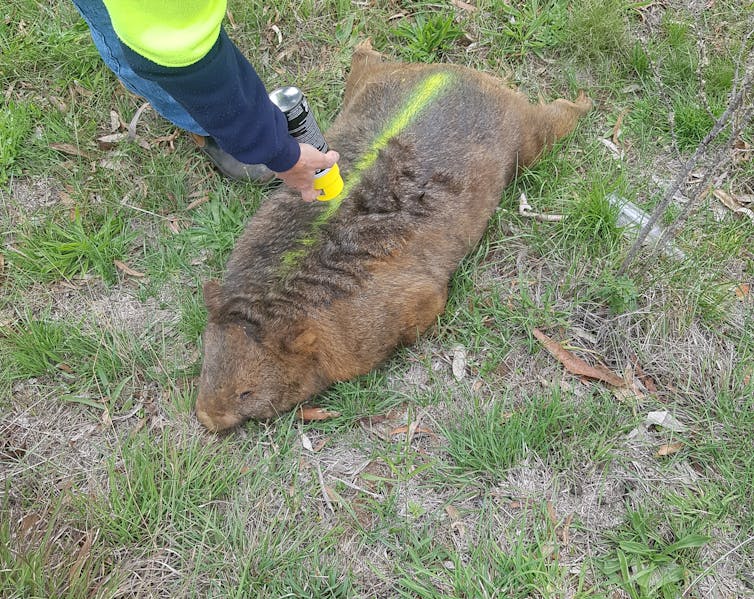
Mangy Marsupials
WomSAT data have also revealed that wombat populations in closer proximity to urban areas have more wombats with sarcoptic mange. Mange is a disease caused by the Sarcoptes scabiei mite.
In people this mite causes scabies. But in wombats, the disease is fatal if left untreated. The mites cause disease by burrowing into the skin of wombats, causing extreme itchiness and discomfort. Eventually it leads to large open wounds, and the wombat dies from secondary infections.
For sarcoptic mange reports, the season was not statistically significant, but rainfall was. This could potentially be because scabies mites thrive in more humid environments, but more research is needed.
Interestingly, our field research has also indicated that rainfall contributes to higher occurrence of sarcoptic mange in specific populations we have monitored over several years.
Overall, roadkill events and sarcoptic mange are two of the biggest threats to bare-nosed wombats. As we continue to track both over time, it will help us to better understand and mitigate these threats.
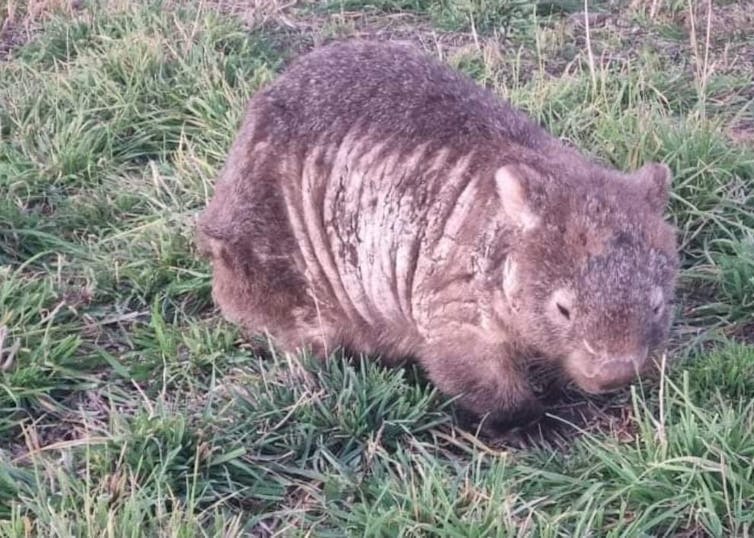
You Can Become A Wombat Warrior Too
Recent upgrades to WomSAT will now allow GPS location data embedded in photos taken using smartphones. Importantly, this means users can upload wombat sightings when they come back into phone signal or internet range.
Users can also now upload information where wombats are not found, which provides important information on wombat distribution and abundance.
Another new feature on WomSAT will assist wildlife carers to directly monitor and record treatment of wombats with sarcoptic mange in the field. In the past, treatment regimes have rarely been recorded. This will benefit the wider wildlife care network by highlighting areas where wombats are currently being treated, as well as new areas where wombats require treatment.
In the longer term, the resource will also help to support the development of better treatment regimes by recording treatment methods and tracking wombats (through photographs) to help monitor their recovery.
Regardless of the level of experience with wombats, everyone can get involved and become a wombat warrior. You can do so by reporting sightings of wombats and their burrows to the WomSAT website via a mobile phone or computer.
Ongoing reporting to WomSAT will provide more insights into these amazing marsupials. It can be used to assist with determining wombat distribution and abundance patterns, as well as help manage the threats they face.![]()
Julie Old, Associate Professor, Biology, Zoology, Animal Science, Western Sydney University and Hayley Stannard, Senior lecturer, Charles Sturt University
This article is republished from The Conversation under a Creative Commons license. Read the original article.
From meerkat school to whale-tail slapping and oyster smashing, how clever predators shape their world

In the 1980s a single humpback whale in the Gulf of Maine developed the “lobtail feeding method”. This unique hunting method of slapping the water’s surface appears to drive fish into dense schools, making it easier to consume them. Lobtail feeding caught on. Now many humpback whales are doing it.
Ecologists have long thought animals acted on instinct alone. But a growing body of evidence shows many animals, much like us, have complex brains and social lives.
In our new research, we argue the science of ecology can learn a great deal from the study of animal cognition and culture. Cognition is what goes on in the mind, which determines how animals perceive and respond to the world around them. Culture is the development and spread of socially learned behaviours. These are important – but generally overlooked – mechanisms influencing ecosystems.
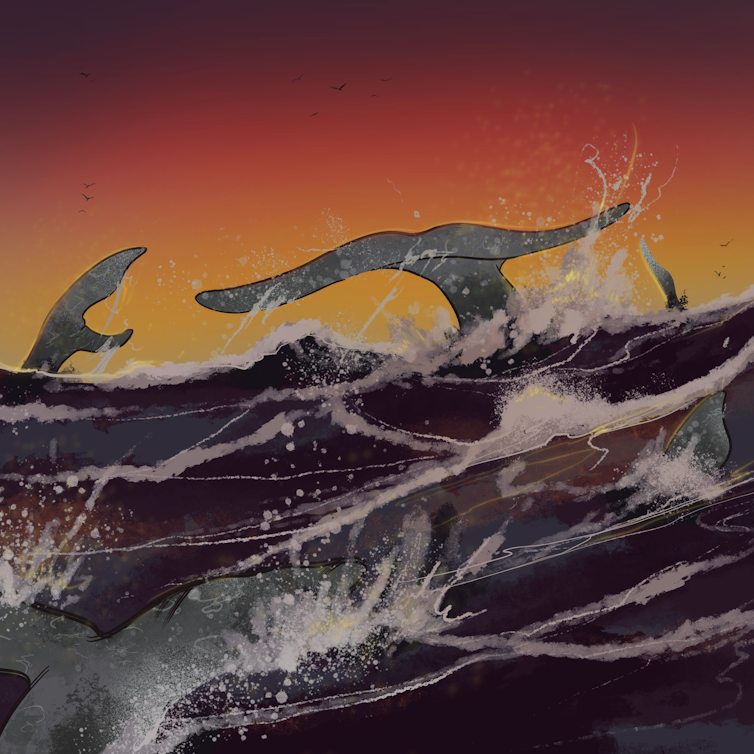
More Than Cogs In The Eco-Machine
Research shows prey are adept at learning from previous encounters with predators. They remember what predators look like, what they smell like and the locations and times they are active.
This means every time an animal encounters a predator they can gather knowledge about how to improve their chances of survival.
Predators learn as well. Meerkat pups go to meerkat “school”. Eating dangerous prey such as scorpions is challenging because scorpion toxin can be fatal. To overcome this, meerkat teach their young how to remove scorpion stingers, allowing them to safely eat them.
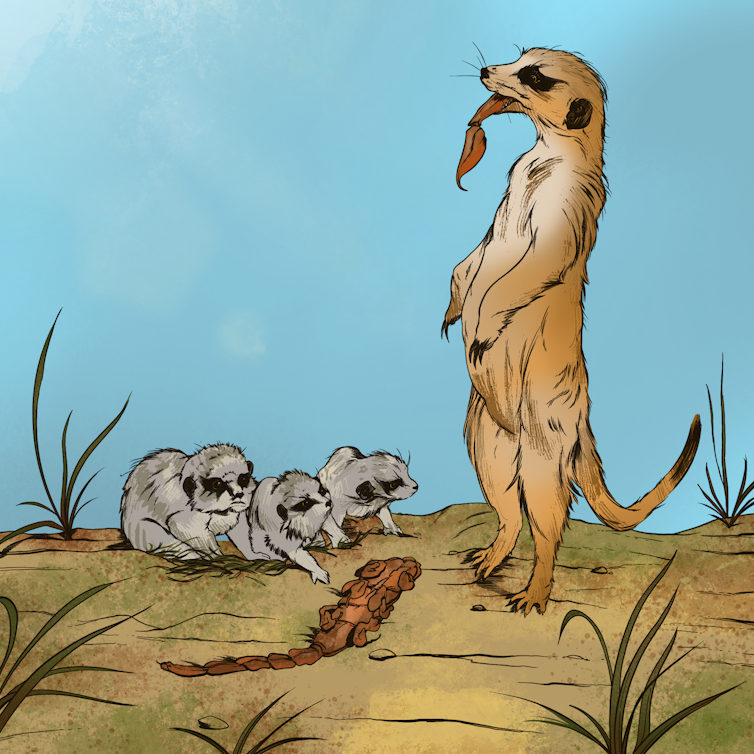
Animal cognition and social learning allow problems solved and lessons learned during predatory encounters to be shared with friends and family. The development of these cultural behaviours can spread across entire populations.
Shaping How Ecosystems Function
Past experience and lessons learned from friends and family inform an animal’s capacity to make complex decisions.
When wolves were reintroduced to Yellowstone National Park in 1995, elk and deer had to learn how to avoid being eaten. While initially naive, elk and deer shifted to new locations and changed the times they were active. As a result, these herbivores concentrated their foraging in specific areas, altering the variety of plants and even the physical environment.
Predator hunting cultures can also shape ecosystems. In Thailand’s Khao Sam Roi Yot National Park, long-tailed macaques use heavy rocks as stone tools to smash the shells of oysters and other shellfish open and access the food inside. Macaques can become so proficient at shellfish hunting they have driven island-wide declines.

Humans Can Erode Animal Culture
Rapid environmental changes such as urbanisation, climate change and hunting or poisoning can influence animal cognition and animal culture.
Just as trauma, such as from war, influences human cognition and culture, the targeted killing of animals can disrupt their cognition and culture. This has consequences for ecosystems.
Killing dingoes, Australia’s only mainland mammalian apex predator, disrupts their family groups. This can result in the loss of important behaviours, including pack hunting. This can then prevent dingoes from hunting prey larger than themselves, such as water buffalo and foxes and cats. In this way, the loss of pack hunting can drive changes in how ecosystems operate and highlights the importance of animal culture as a unit of nature worth conserving.
Changing Our Perceptions Of Ecology
Longstanding notions in ecology and conservation biology claim ecosystems function due to evolutionary history alone. In this view, organisms evolve traits to allow them to coexist with each other, so newly arrived species can be fundamentally disruptive. The inner lives of animals complicate this worldview.
Recognising many animals possess and act upon their awareness of time, self and others, and may even have language, invites us to reconsider ecological relationships might not be so static. Acknowledging animal cognition and culture in ecology means understanding ecological relationships are always changing and shifting.
By studying how the cognition and cultures of animals shape their ecology, we may shed light on the origins of animal intelligence and culture, their importance to life on Earth and how best to preserve non-human culture in an ever-changing world.
The research behind this article was co-authored with Dr Kaitlyn Gaynor, Dr Alexandra Carthey, Dr Arian Wallach, Dr Lauren Stanton and Dr Daniel Ramp who all substantially contributed to the ideas presented throughout.![]()
Eamonn Wooster, Postdoctoral Research Fellow, Gulbali Institute, Charles Sturt University and Erick Lundgren, Postdoctoral fellow, Aarhus University, University of Technology Sydney
This article is republished from The Conversation under a Creative Commons license. Read the original article.